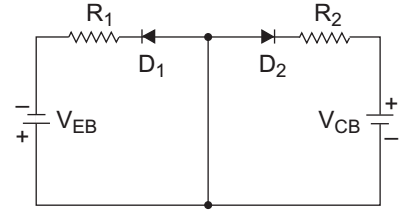-
Two p-n junction diodes are connected back to back to make a transistor. Which one of the following is correct?
-
- The current gain of such a transistor will be high
- The current gain of such a transistor will be moderate
- It cannot be used as a transistor due to large base width
- It can be used only for pnp transistor
Correct Option: C
Two p-n junction diodes are connected back to back cannot be used as a transistor due to large base width. Although, it is said that a transistor is a device in which two pn-junctions diodes are connected back-to-back. But it does not mean that two discrete diodes connected back-to-back can work as a transistor. In this case, each diode has two equally doped regions, so that the overall circuit has four equally doped regions. Given below shows the arrangement of two diodes
connected back-to-back. This would not work because in this case base is wide and equally doped whereas in actual transistor base is very thin and lightly doped.
In n-p-n transistor, the free electrons passing through the base to the collector have a short life time. As long as base thin, the free electrons can reach the collector. But is case two discrete back-to-back diodes, there are four doped region instead of three. Hence two diodes connected back-to-back can never work as a transistor.


